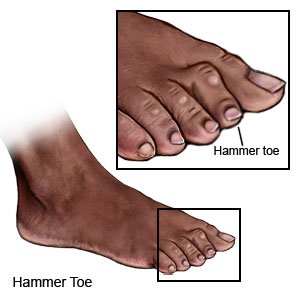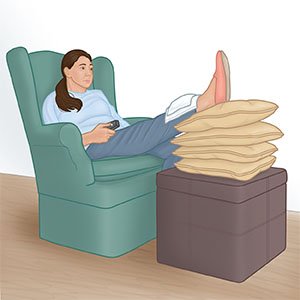Hammertoe Correction
Medically reviewed by Drugs.com. Last updated on Apr 6, 2025.
Hammertoe correction is surgery to straighten your toe. A hammertoe is abnormal bending of your toe. The part of your toe attached to your foot bends up, and the tip bends down.
 |
DISCHARGE INSTRUCTIONS:
Call your doctor or surgeon if:
- Blood soaks through your bandage.
- Your stitches come apart.
- Your foot or toe becomes cold to the touch or looks blue or black.
- You have severe pain in your foot or toe.
- You have a fever or chills.
- Your wound is red, swollen, or draining pus.
- Your toe or foot is numb, weak, or stiff.
- Your toe is out of position or is starting to bend again.
- You have questions or concerns about your condition or care.
Medicines:
You may need any of the following:
- NSAIDs , such as ibuprofen, help decrease swelling, pain, and fever. NSAIDs can cause stomach bleeding or kidney problems in certain people. If you take blood thinner medicine, always ask your healthcare provider if NSAIDs are safe for you. Always read the medicine label and follow directions.
- Prescription pain medicine may be given. Ask your healthcare provider how to take this medicine safely. Some prescription pain medicines contain acetaminophen. Do not take other medicines that contain acetaminophen without talking to your healthcare provider. Too much acetaminophen may cause liver damage. Prescription pain medicine may cause constipation. Ask your healthcare provider how to prevent or treat constipation.
- Antibiotics help prevent or treat an infection caused by bacteria.
- Take your medicine as directed. Contact your healthcare provider if you think your medicine is not helping or if you have side effects. Tell your provider if you are allergic to any medicine. Keep a list of the medicines, vitamins, and herbs you take. Include the amounts, and when and why you take them. Bring the list or the pill bottles to follow-up visits. Carry your medicine list with you in case of an emergency.
Wound care:
Care for your wound as directed. Check the wound for signs of infection, such as redness, swelling, or pus. Carefully wash the wound with soap and water. Dry the area and put on new, clean bandages as directed. Change your bandages when they get wet or dirty.
Self-care:
- Elevate your foot as often as you can. This will help decrease swelling and pain. Prop your foot on pillows or blankets to keep it elevated above the level of your heart comfortably.

- Wear wide, rounded, or square-tipped shoes. The tip needs to have extra room so your toe does not rub against it. Do not wear high-heeled shoes.
- Return to your daily activities as directed. You may need to wait at least 2 weeks after surgery. Do not drive until healthcare providers say it is okay.
Follow up with your surgeon within 1 week or as directed:
You will need to return to have your stitches removed or to have x-rays. If you had a wire put into your toe, your surgeon will remove it in 4 to 8 weeks. He or she will tell you when to come in to have this done. Write down your questions so you remember to ask them during your visits.
© Copyright Merative 2025 Information is for End User's use only and may not be sold, redistributed or otherwise used for commercial purposes.
The above information is an educational aid only. It is not intended as medical advice for individual conditions or treatments. Talk to your doctor, nurse or pharmacist before following any medical regimen to see if it is safe and effective for you.
Further information
Always consult your healthcare provider to ensure the information displayed on this page applies to your personal circumstances.
